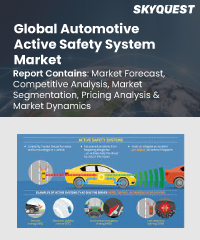
Report ID: SQMIG25A2180

Report ID:
SQMIG25A2180 |
Region:
Global |
Published Date: October, 2024
Pages:
223
|
Tables:
171 |
Figures:
79
Global Automotive Active Safety System Market size was valued at USD 12.2 billion in 2022 and is poised to grow from USD 14.46 billion in 2023 to USD 56.21 billion by 2031, growing at a CAGR of 18.50% during the forecast period (2024-2031).
The key emerging trend in the automotive active safety system industry is the integration of artificial intelligence (AI) and machine learning (ML) into safety engineering. For example, AI-powered systems can analyze large amounts of data from sensors and cameras to make split-second decisions to predict and prevent collisions. This technology also allows them to learn continuously, and the systems improve as they encounter driving conditions.
This trend not only improves the effectiveness of active safety systems, but also opens the way for more advanced autonomous vehicles. One of the major challenges in the automotive active safety system market is the rising cost of advanced safety systems. These systems, such as anti-lock braking systems, electronic stability control and advanced sensors, require advanced technology and materials, increasing vehicle manufacturing costs. This can increase vehicle prices for safety and can be bought for automakers especially in high-cost markets. Cost can also slow the adoption of this technology, especially in developing regions. Continuous advances in sensor technology, artificial intelligence and connectivity have paved the way for new dynamic security systems. Vehicles are equipped with radar, cameras, lidar, and other sensors to monitor the captured environment in real time.
The global automotive active safety system market has witnessed tremendous growth in recent years, pushed by various products that prioritize passenger and vehicle safety. Active safety systems are becoming key features in modern vehicles, aimed at reducing the risk of accidents and enhancing general road safety.
Our industry expert will work with you to provide you with customized data in a short amount of time.
REQUEST FREE CUSTOMIZATIONWant to customize this report? This report can be personalized according to your needs. Our analysts and industry experts will work directly with you to understand your requirements and provide you with customized data in a short amount of time. We offer $1000 worth of FREE customization at the time of purchase.

Report ID: SQMIG25A2180